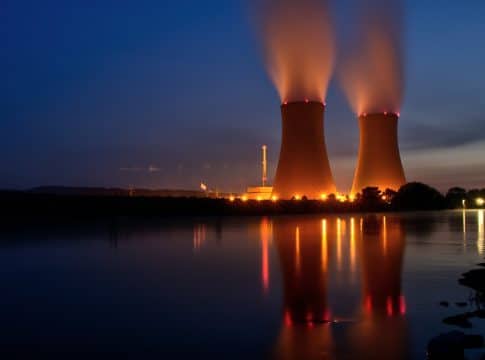$7.1 Billion Investment Fuels Fusion Commercialization. Is Fusion the Future Energy?
Fusion is the future of energy, and that’s becoming increasingly evident. How? Well, recently tech giant Microsoft invested generously in Helion Energy as it recognized fusion’s potential to revolutionize the energy transition.
Andrew Holland, CEO of the Fusion Industry Association explained this very nicely by stating,
“The fusion industry is poised to help the world achieve the energy transition to net zero carbon emissions. Commercialization of fusion energy will create new jobs and a new industry addressing a trillion-dollar market.”
Recently they published the Global Fusion Industry Report that highlights how the race to commercialize fusion energy is speeding up. We discovered that forty-five companies are putting in various technological efforts and have raised over $7 billion in investments till now. Notably, with public-private partnerships the funding has seen a 50% jump.
President Biden and his climate agenda are one of the propellers for addressing the climate crisis. The US DOE says fusion energy has immense potential to meet carbon reduction targets, ensure energy security, and promote economic growth.
Moving on, let’s understand what is fusion.
Fusion and Its Fuel
In Chemistry,
“Nuclear fusion is the process by which two light atomic nuclei combine to form a single heavier one while releasing massive amounts of energy. The sun, along with all other stars, is powered by this reaction.”
IAEA says, Fusion could generate 4X more energy per kilogram of fuel than fission (used in nuclear power plants) and nearly four million times more energy than burning oil or coal.
From this estimate, we can fathom the impact of fusion in the future once it’s fully deployed. Secondly, there are particular fuels that trigger fusion. The deuterium-tritium (D-T) fuel is the most efficient for fusion devices.
As fusion produces safe, clean, and infinite energy, it’s crucial to find a viable fuel source to power the process. Top fusion companies are working on several other alternatives along with D-T. A few examples are proton–boron (pB11), deuterium–helium3 (DHe3), and lithium.
However, turning this into reality involves rigorous R&D and investments. And this is why public-private partnerships have become inevitably important for the fusion industry.
Public-Private Partnerships Drive Fusion Commercialization
One cannot overlook the role of public-private partnerships as they are the driving factor behind the commercialization of fusion energy. Government funding to support private companies has jumped by over 50%. This indicates a keen interest from national governments. The investment figures are shown below:
While private companies will take charge of the commercialization, public partnerships will drive scientific research and emerging technologies. The Fusion Industry Association has consistently pushed for such collaborations to ensure that private companies can leverage maximum knowledge from public research programs.
Several notable public-private partnerships have gained momentum in the past year. In June 2024, the U.S. DOE signed contracts with eight companies under the Milestone-Based Fusion Development Program to deliver pilot plant designs. Even ITER, the global leader in fusion research, is embracing public-private partnerships by offering its expertise to private companies.
Germany launched its “Fusion 2040” initiative, directly investing in private companies, while Japan’s “Moonshot” program and the UK’s “Fusion Futures” are backing key technology providers. Meanwhile, the EU plans to establish a fusion investment consortium by 2026.
READ MORE: Why the Nuclear Energy Market Is Poised for a Major Comeback
Potential Markets for Fusion Energy
The demand for fusion commercialization can be met only with international cooperation. This is because such partnerships can overcome research challenges, boost supply chains, and train workforces.
Thus, building a global fusion energy market requires turning rigorous R&D efforts into commercial technologies. Fusion developers aim to export facilities worldwide. This can help us understand the diverse commercial landscapes essential for global collaboration.
The DOE has outlined a pathway of how international partners can support fusion’s entry into these markets. The steps are:
Identifying necessary technologies, manufacturing, and infrastructure for fusion development, while mapping global supply chains to target high-value markets.
Exploring common benchmarks and standards.
Engaging with industry groups, consortia, and NGOs to address commercial and community needs.
Helping multinational companies benefit from technologies developed outside their home countries.
Additionally, coordinating early on regulatory frameworks and policies will also ensure a smooth market entry for fusion energy. This will also involve scaling from prototypes to real-world solutions. However, with major advancements, protecting intellectual property will also become crucial for R&D, commercialization, and global partnerships.
Take a peek at the following chart to discover the industries where fusion energy will be useful.
Commonwealth Fusion Systems: Leading the Pack
Located in Devens, Massachusetts, Commonwealth Fusion Systems is the world’s largest commercial fusion energy company. To date, it has secured around $2 billion in funding having a primary market for electricity generation.
The company aims to deploy fusion power plants quickly to meet rising global energy demands and achieve decarbonization goals. It specializes in making tokamaks (a magnetic confinement device to generate thermonuclear fusion) with innovative high-temperature superconducting (HTS) magnet technology. The company is currently building SPARC, a Q~10 demonstration plant that uses actual fusion fuels based on peer-reviewed science. Catch a glimpse of the reactor here.
Source: CFS
Recently the power giant produced two advanced superconducting magnets for the University of Wisconsin’s WHAM experiment, which is exploring magnetic mirror fusion. These are the first products shipped under CFS’s plan to supply magnets for both its power plants and other innovative uses.
While CFS’s main focus is building its own fusion devices, including the SPARC tokamak, its cutting-edge magnet technology has broader potential. Several companies have already approached CFS for its expertise in developing high-temperature superconducting magnets for various markets.
The top fusion companies are charted in the image below:
“Recreating the conditions in the center of the Sun on Earth is a huge challenge”
The above statement was said by Dr. Aneeqa Khan, lecturer in nuclear materials at the University of Manchester to BBC. Building a fusion power plant involves complex engineering and material challenges. It also requires trained and a large workforce with precision and skills to work in this field.
Understand the diverse challenges of the fusion sector from this figure:
Commercial fusion power will still take time to develop. However, investment in fusion is surging and the companies are making steady progress to bring this technology to the world sooner in the future.
Disclaimer: Data and Visuals Collected from 2024 Global Fusion Industry Report
FURTHER READING: Google and Kairos Power Unveil Groundbreaking 550 MW Nuclear Energy Initiative
The post $7.1 Billion Investment Fuels Fusion Commercialization. Is Fusion the Future Energy? appeared first on Carbon Credits.



